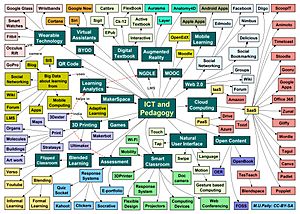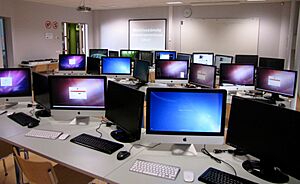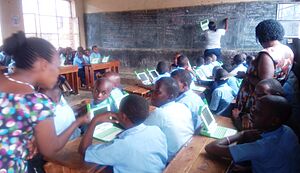Information and communications technology facts for kids
Information and communications technology (ICT) is a big term that includes all the tools and systems we use to share and understand information. Think of it as a wider version of information technology (IT). ICT brings together things like telephone lines, wireless signals, computers, and all the software that helps us access, store, send, and use information.
ICT also means that different communication systems, like phone networks and computer networks, are now connected using one system. This is great because it saves money and makes things simpler. ICT covers almost any device that helps us communicate, such as radios, televisions, cell phones, computers, satellite systems, and even services like video conferencing and distance learning. It's not just digital stuff; it can also include older ways of sharing information, like paper.
ICT is always changing and growing. It includes anything that stores, gets back, changes, sends, or receives information electronically. This means things like smartphones, digital television, email, and even robots.
Contents
What Does ICT Mean?
The full phrase "information and communication technologies" has been used by smart people since the 1980s. The shorter version, "ICT," became popular in the UK after a report in 1997 and was then used in school lessons around 2000. However, in 2012, some experts suggested that schools in Britain should stop using "ICT" because it had gotten a bad reputation. So, from 2014, the school curriculum started using the word computing instead, which now includes computer programming.
The idea of ICT has spread all over the world. The United Nations even has groups dedicated to information and communication technologies.
Money Spent on ICT
A lot of money is spent on ICT around the world. In 2017, about $3.8 trillion was spent, and this amount keeps growing every year. The biggest growth is happening in new technologies like the Internet of things (IoT), Robotics, Augmented reality (AR), Virtual reality (VR), and Artificial intelligence (AI).
Most of the money spent by companies on IT goes to keeping their current systems running. Only a smaller part is used for new technology projects. Experts believe that by 2022, over $6 trillion will be spent on ICT.
How Much Information Can We Handle?
The world's ability to store information has grown hugely! In 1986, we could store about 2.6 exabytes of data. By 2014, this had jumped to about 5 zettabytes! To give you an idea, 5 zettabytes is like having 4,500 stacks of printed books reaching from the earth all the way to the sun.
Our ability to receive information through things like TV and radio broadcasts also grew a lot, reaching 1.9 zettabytes in 2007. And our ability to exchange information through two-way networks, like the internet, grew from 281 petabytes in 1986 to about 100 exabytes in 2014.
The power of computers to process information has also increased massively, showing how much technology has advanced.
ICT's Role in Different Countries
The Organisation for Economic Co-operation and Development (OECD) tracks how much of a country's economy comes from the ICT sector. Here's a look at some countries in 2013:
| Rank | Country | ICT sector in % |
|---|---|---|
| 1 | 10.7 | |
| 2 | 7.02 | |
| 3 | 6.99 | |
| 4 | 6.82 | |
| 5 | 6.09 | |
| 6 | 5.89 | |
| 7 | 5.87 | |
| 8 | 5.74 | |
| 9 | 5.60 | |
| 10 | 5.53 |
This table shows that some countries, like South Korea and Japan, have a very large ICT sector, meaning technology plays a big part in their economies.
ICT Development Around the World
The ICT Development Index (IDI) is a way to compare how different countries use and access ICT. In 2014, Denmark was ranked first, followed by South Korea. The top countries on this list are usually high-income countries where people generally have a good quality of life. This shows that access to ICT often goes hand-in-hand with development.
ICT and Global Goals
In 2001, the United Nations General Assembly decided to hold a meeting called the World Summit on the Information Society (WSIS). The goal was to talk about how ICT could help achieve the United Nations Millennium Declaration goals, which aimed to improve life for people around the world. They wanted everyone, including governments, businesses, and regular people, to work together.
By 2015, the UN had set a deadline for achieving these goals, and ICT was seen as a key tool to help reach them, especially in connecting people in every part of the world.
ICT in Education
Using ICT in schools can be very effective, especially when it's fully part of how teachers teach. For example, when teaching reading, writing, and math, using ICT along with writing activities can lead to better results than just traditional teaching methods or ICT alone.
UNESCO, a part of the United Nations, works to make sure everyone has fair access to education. They believe that ICT can help with this. UNESCO says that ICT can:
- Help everyone get an education.
- Make education fair for all.
- Improve the quality of learning and teaching.
- Help teachers grow professionally.
- Make managing schools and education systems more efficient.
Even though computers can really improve learning, sometimes they aren't used properly in classrooms. It's not just about having more money or better technology. Teachers' beliefs about how to teach, their feelings about computers, and how comfortable they are using them can all affect how well ICT is used in the classroom.
Mobile Learning for Refugees
Learning a new language is very important for refugees, but language differences can make it hard for them to go to school. Mobile apps can be a great help for learning languages. They can help with reading and writing skills, learning new languages, and even translations. Mobile phones are useful because they help refugees communicate and connect with new cultures, which helps them learn in real-life situations.
ICT in Developing Countries
Africa
ICT has been used to improve education in Sub-Saharan Africa since the 1960s, starting with TV and radio. These technologies helped education reach beyond classrooms, even to remote areas. As technology improved, so did efforts in Africa. In the 1990s, a big push brought computers into schools to help students and teachers learn about them. Projects like the One Laptop per Child (OLPC) program have given millions of laptops to students and teachers.
Using ICT in classrooms, often called M-learning (mobile learning), has helped teachers reach more students and track their progress better in Sub-Saharan Africa. Mobile phones have been especially important because they are widely used and mobile networks cover more areas than internet networks. Phones are familiar to everyone and allow for more communication and access to learning materials. M-learning also helps train teachers, leading to more consistent teaching across different schools. UNESCO even holds a yearly event called Mobile Learning Week to discuss mobile learning.
However, there are still challenges. While mobile phone and internet use are growing quickly in Sub-Saharan Africa, they are still slower than in developed countries. Also, things like gender, social issues, and political problems can stop children from going to school. Many children in Sub-Saharan Africa are not in school because of these reasons, as well as a lack of good teachers or learning materials.
ICT Growth and Limits
In today's world, ICT is everywhere. More than three billion people use the internet, and most internet users have a smartphone. This means a huge amount of information is being created every day. This fast growth, especially in developing countries, has made ICT a key part of daily life. Without some form of technology, many everyday tasks would be very difficult.
Recent information from 2014 shows that internet use keeps growing steadily. The number of internet users in developing countries has doubled in just five years. Now, two-thirds of all people online live in developing countries.
However, there are still big challenges. About 4.3 billion people don't use the internet yet, and 90% of them live in developing countries. In the world's least connected countries, access to ICT is still very hard to get, especially for people in rural areas. Many developing countries don't have internet, telephone lines, or even good cell phone service. Even though cell phone coverage is increasing, many people have multiple phones, so the real improvement in connectivity for those who need it most isn't always as big as it seems. About 450 million people still live in places without mobile phone service.
The good news is that the gap between internet access and mobile coverage has shrunk a lot in the last fifteen years. ICT continues to change, with new technologies like nanotechnology bringing in new gadgets. Things like smartwatches, smart wristbands, and smart TVs are becoming common. As desktops become less popular and laptops become the main way to compute, ICT keeps changing and shaping our world.
ICT also helps new social movements. The internet makes it easier for groups to form and take action, allowing people to discuss politics and directly influence government decisions.
ICT in Health Care
ICT is used in many ways to improve health care:
- Telehealth: This means getting health care from a distance, often through video calls. Studies show that this can be just as good as in-person care.
- Artificial intelligence in healthcare: AI helps doctors make better decisions.
- Use and development of software for COVID-19 pandemic mitigation: Software helped manage the pandemic.
- MHealth: Using mobile devices for health care.
- Clinical decision support systems: Computer systems that help doctors with diagnoses and treatments.
- Health administration and hospital information systems: Systems that manage hospital records and operations.
ICT in Science
ICT is also very important in science and research:
- Internet research: Using the internet to find information for studies.
- Online research methods: Doing research using online tools.
- Science communication: How scientists share their findings with each other and the public.
- Scholarly databases: Online collections of scientific papers.
Ways to Access ICT
A scholar named Mark Warschauer talks about three main ways people get access to ICT:
- Devices: This is simply owning a device like a phone or computer. But just owning a device isn't enough. You also need software, internet access, and the knowledge to use it.
- Conduits: This means having a connection, like a phone line or internet line. Getting these connections requires money for infrastructure and monthly payments. This can create divides, especially for people in rural areas or those with lower incomes. Many people now rely on smartphones for internet access, often using free Wi-Fi in public places.
- Literacy: This is the most important part. It's not just about knowing how to click buttons, but understanding how to use ICT effectively. Just like reading and writing, ICT literacy isn't a single skill; it's a range of abilities that depend on what you need to do.
So, having access to ICT means more than just having a device or an internet connection. It also means having the skills, knowledge, and social support to use technology well. If ICT is used correctly, it can help people grow and develop. If not, it can make existing problems worse.
ICT and the Environment
ICT's Impact on the Planet
In the early 2000s, ICT services and electronic devices grew very quickly. The number of internet servers, for example, multiplied by 1000! This growth is partly explained by Moore's law, which says that ICT technology improves by 16-20% every year.
However, this rapid development and the high demand for ICT products have a big impact on the environment. By 2008, the production of software and hardware was causing as much carbon dioxide (CO2) pollution as all global air travel.
ICT has both good and bad sides for the environment. On the good side, studies show that in developed countries, more ICT use can lead to a small reduction in energy use. On the other hand, the more we use digital technology, the more energy we consume. For example, in developed countries, a 1% increase in internet users causes a small rise in electricity use. For developing countries, this impact is much higher.
Scientists predict that energy use by ICT will increase dramatically by 2030, becoming 20 times higher than it was in 2010.
Dealing with Environmental Issues
To help with ICT's environmental problems, the European Commission plans to track and report the Greenhouse gas (GHG) emissions from different ICT platforms and countries. They also want to create international rules for reporting to make things more transparent.
Experts also suggest investing more in ICT to help reduce CO2 emissions overall. They recommend better coordination between ICT, energy, and growth policies. This means investing in places where it's cheapest to reduce emissions, often in developing countries that have older technology. By doing this, ICT can help reduce environmental damage from economic growth and energy use by making communication and infrastructure more efficient.
ICT for Solving Problems
ICT can also be used to help solve environmental problems, including climate change. It can do this in many ways, not just through education.
See also
 In Spanish: Tecnologías de la información y la comunicación para niños
In Spanish: Tecnologías de la información y la comunicación para niños
- Behavioral change support system
- Cloud computing
- Digital divide
- Gender digital divide
- Information Age
- Mobile web
- 21st century skills
- Information technology





